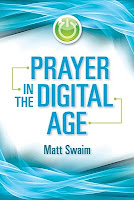During my research for The Church and New Media, I spent a lot of time exploring how technology affects religion. Perpetual dialogue, shallower relationships, and increased narcissism were some of the many effects I discovered. Matt Swaim, producer of EWTN’s “Son Rise Morning Show”, has done similar research and has observed even more.
In his new book, Prayer in the Digital Age (Liguori, paperback, 160 pages), Matt probes the relationship between technology and prayer. Among many topics, he considers the difficulty of silence in our noisy world, our discomfort with God’s own quietness, the emptiness of virtual identities, and the temptation to consume too much information. Each of these obstacles hinders our prayer life, Matt explains, and each one has been amplified in our digital world.
Despite the title’s suggestion, Prayer in the Digital Age doesn’t deal specifically with tools like Facebook, Twitter, or YouTube. The book is more abstract than practical, but that’s a needed approach for a world that overvalues pragmatism. Most people become enamored by a new digital tool and dive right in without considering its effects. Matt’s book, on the other hand, teaches us to detect the effects of technology. With this awareness, we can be more confident that we are using technology and not the other way around.
Prayer in the Digital Age is definitely not a beginner’s prayer book. Matt leans on giants like St. Thomas Aquinas and St. John of the Cross. And he philosophizes on hope and happiness, gauging how technology affects the “summa bonum”–the highest good in life.
All this means that the book is not a quick read, but I actually count that as a positive. Matt forces you to chew, contemplate, and even pray through his words–it doesn’t take many pages to attract you toward silence–a welcome relief to the shallowness we typically wade in through the blogosphere.
Another great component is the book’s Appendix, which covers “Patron Saints of the Digital Age.” Each entry features a saint’s name, their patronage, and a short biography describing how they influence digital culture. As we consider how to respond to technology, this Appendix stands as a great source for both guidance and prayers.
My only qualm with the book is that it focuses primarily on technology’s negative effects on prayer. In many ways, I think prayer can actually be aided by new tools. But that’s not to say that Matt is an alarmist by any measure. In the book, Matt acts as both a digital tour guide and a spiritual medic. He points out the subtle, oft-neglected dangers of the digital world, but instead of just stopping there he provides antidotes for each.
If you’re looking to learn the basics of prayer or some practical ways that technology can help you pray, this might not be your book. But if you want to recognize the spiritual dangers lurking within the digital world, check out Prayer in the Digital Age.
Bonus Content
- Purchase the paperback or Kindle edition
- The Prayer in the Digital Age Facebook page
- A good interview with Matt where he shares his conversion story

